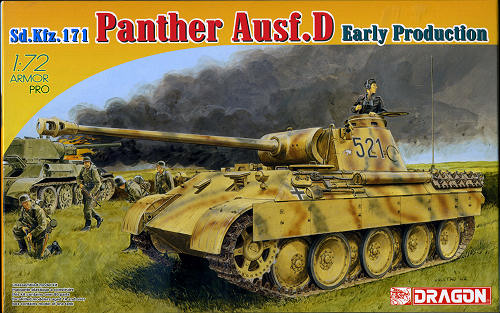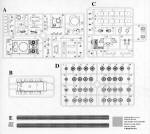
Dragon 1/72 SdKfz 171 Panther ausf D (Early)
| KIT #: | 7494 |
| PRICE: | $23.50 SRP |
| DECALS: | Five options |
| REVIEWER: | Scott Van Aken |
| NOTES: | Armor Pro |

| HISTORY |
The Panther was a direct response to the Soviet T-34. First encountered on 23 June1941, the T-34 decisively outclassed the existing Panzer IV and Panzer III. At the insistence of General Heinz Guderian a team was dispatched to the Eastern Front to assess the T-34. Among the features of the Soviet tank considered most significant were the sloping armor, which gave much improved shot deflection and also increased the effective armor thickness against penetration, the wide track and large road wheels which improved mobility over soft ground, and the 76.2 mm gun, which had good armour penetration and fired an effective high-explosive round. Daimler-Benz (DB) and Maschinenfabrik Augsburg-Nürnberg AG (MAN) were tasked with designing a new thirty to thirty-five-ton tank, designated VK3002, by April 1942 (apparently in time to be shown to Hitler for his birthday).
The two proposals were delivered in April 1942. The Daimler-Benz (DB) design was a direct homage to the T-34, side-stepping the German propensity for over-engineering and, hence, complexity, to produce a clean, simple design resembling the T-34 in hull and turret form, diesel engine, drive system, leaf spring suspension, track layout, and other features. In the DB design, like the T-34 design, the internal crew layout provided for two men: the commander would also have to serve as the gunner. This provided the advantage of a smaller, inexpensive turret design, as well as manpower savings, and a smaller target for enemy gunners to hit during a battle.
The MAN design was more conventional German thinking: it was higher and wider with a substantial turret placed centrally on the hull, a petrol engine, torsion-bar suspension, and a characteristically German internal crew layout for three men: commander, gunner, and loader. The MAN design was accepted in May, 1942 in spite of Hitler's preference for the DB design. One of the principal reasons for this was that the MAN design used an existing turret designed by Rheinmetall-Borsig while the DB design would have required a brand new turret to be designed and produced, substantially delaying the commencement of production.
A mild steel prototype was produced by September 1942 and, after testing at Kummersdorf, was officially accepted. It was put into immediate production with the very highest priority. The start of production was delayed, however, mainly because there were too few specialized machine tools needed for the machining of the hull. Finished tanks were produced in December and suffered from reliability problems as a result of this haste. The demand for this tank was so high that the manufacturing was soon expanded out of MAN to include Daimler-Benz and in 1943 the firms of Maschinenfabrik Niedersachsen-Hannover (MNH) and Henschel & Sohn in Kassel.
The initial production target was 250 tanks per month at MAN. This was increased to 600 per month in January 1943. Despite determined efforts this figure was never reached due to disruption by Allied bombing, manufacturing bottlenecks, and other difficulties. Production in 1943 averaged 148 per month. In 1944, it averaged 315 a month (3,777 having been built that year), peaking with 380 in July and ending around the end of March 1945, with at least 6,000 built in total. Strength peaked on September 1, 1944 at 2,304 tanks, but that same month a record number of 692 tanks were reported lost (source: T.L. Jentz (1999) Die deutsche Panzertruppe Band 2).
The ausf D was actually the initial production version with around 800 or so built between January and September 1943.
| THE KIT |
 This one continues with Dragon's nicely done 1/72 armor kits. One thing about Dragon is that they try to give you the highest level of detail they can in their kits. This one is no exception. While some modelers would like to have a lot of the bits attached to the hull molded on, others prefer the additional detail. This kit also comes with Dragon's fine DS tracks, which can be rather easily painted and attached. I like that the inner road wheels are molded as a single unit rather than individually. There are other features on the kit and I will let the Dragon PR folks take care of that.
This one continues with Dragon's nicely done 1/72 armor kits. One thing about Dragon is that they try to give you the highest level of detail they can in their kits. This one is no exception. While some modelers would like to have a lot of the bits attached to the hull molded on, others prefer the additional detail. This kit also comes with Dragon's fine DS tracks, which can be rather easily painted and attached. I like that the inner road wheels are molded as a single unit rather than individually. There are other features on the kit and I will let the Dragon PR folks take care of that.
- Authentic Panther Ausf.D newly produced
- On-vehicle tools reproduced w/clasps
- Turret sides molded w/details including ports
- Engine deck grills molded w/intricate details
- One-piece slide-molded lower hull
- Bolts and rivets delicately represented on hull bottom
- Finely detailed front headlights
- Finely detailed exhaust pipes, jack and rear stowage boxes molded on hull rear
- One-piece side armor skirts
- Easy-to-assemble idlers and sprocket wheels look authentic
- One-piece DS tracks
Instructions use both Gunze and Model Master paint references and there are five vehicle options:

Black 521 is with PzAbt 52 at Kursk in 1943, Black 101 is with Pz Rgt 14 in Ukraine during 1943, Black 445 is at Karachev in 1943 with 4 PzRgt 'Grossdeutchland', Black 745 and Black 824 are both with 39 PzRgt at Kursk in 1943, though with different battalions. The small decal sheet is well printed and provides what few markings are needed. I found it interesting that not all of these tanks carries a cross insignia on the side or front of the tank.
| CONCLUSIONS |
For those wanting a nice early Panther, you now have one available. This is a beauty and should do quite well.
| REFERENCES |
May 2012
Thanks to www.dragonmodelsusa.com for the preview kit. You can probably get this one today at your local hobby shop.
If you would like your product reviewed fairly and fairly quickly, please contact the editor or see other details in the